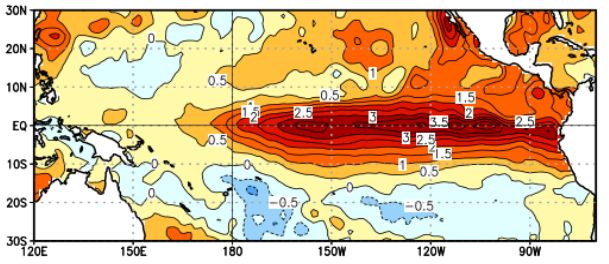New research reveals El Niño pattern in contradiction with top climate models

An international team of scientist has conducted a study of fossil corals and mollusk shells from the Pacific Ocean which has shown there is no link between the strength of seasonal differences and El Niño. This discovery seems to cast a shadow of doubt on the top climate models in use today, known to connect the extreme seasonal weather events with the strength of El Niño.
El Niño, a complex and irregular climate pattern resulting from the ocean temperature variations of the Equatorial Pacific, is commonly considered to have a profound impact on the global weather and climate with wide implications for agriculture, fisheries, tourism and air quality across the globe.
The new research, based on an analysis of fossils from the Pacific Ocean, shows there are more questions that need our attention and that existing climate models still need improvement.
"The idea behind this link is based on very well-established physics, so it's appealing to think that nature works this way. But our analysis shows that it's not that simple," said Julien Emile-Geay, assistant professor of Earth Sciences at the University of South California (USC) Dornsife College of Letters, Arts and Sciences, a lead author of the study.
The scientist have compared the modeling results with the data collected from shells and fossil corals form the Holocene period spanning across the last 10 000 years of Earth's history. This period of our planet's history had similar geography, amounts of ice and levels of greenhouse gases present in the atmosphere, providing a good benchmark for our present climate.
Shells form by crystallizing calcium carbonate from the surrounding water and they and thus record information about its temperature and salinity. The capture the prevalence of various isotopes of oxygen, which vary with the sea surface temperature.
The research team has analyzed almost 60 species from different locations across the Pacific Ocean which enabled them to create a spatially and time-distributed data set capable of providing an insight into the amplitude of seasons and the intensity of El Niño throughout the past 10 000 years.
The datasets have then been compared to the predictions of the nine top most used climate models and discovered there was a mismatch in the length of subdued El Niño periods, such as those which occurred between 3 000 and 5 000 years ago.
"The causes for prolonged periods of weak El Niño are either beyond the current models, or we're missing an important piece of the puzzle. This points to deficiencies in the way these models simulate various aspects of tropical Pacific climate, from average conditions, to the march of seasons, to El Niño itself," Emile-Geay said.
This findings will hopefully be used to improve the existing climate models and fill in the missing pieces of the puzzle.
"Building climate models is like building a ladder to the Moon. They are not perfect but they are reaching for the heavens. It's a long process, and one in which the paleoclimate record can teach us a lot about the inner workings of the climate system."
Reference:
- "Links between tropical Pacific seasonal, interannual and orbital variability during the Holocene" – J. Emile-Geay, K. M. Cobb, M.Carré, P. Braconnot, J. Leloup, Y. Zhou, S. P. Harrison, T. Corrège, H. V. McGregor, M. Collins, R. Driscoll, M. Elliot, B. Schneider&A. Tudhope – Nature Geoscience (2015) – doi:10.1038/ngeo2608
Featured image: Average sea surface temperature anomalies in the period between November 15 and December 12, 2015. Image credit: NOAA

Your in-group identifier giving you away notwithstanding, your write-up isn’t even close to the focus of the paper.
Best,
D